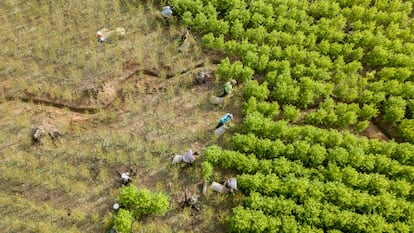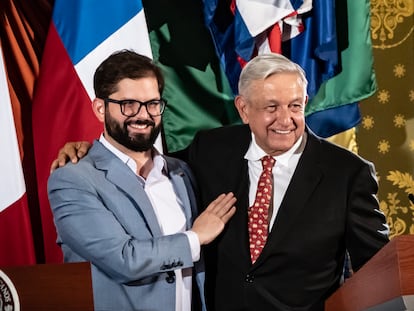Colombia sets new records for coca crops and cocaine production
The number of planted hectares went from 204,000 to 230,000 during 2022, while the tonnage of drugs that has been produced reached 1,738, the highest figures ever recorded


There seems to be no limit to how many coca plants Colombia can grow. The country has reached figures that have never been previously seen in the sector dedicated to the base product of cocaine, with 230,000 hectares throughout its territory now dedicated to growing coca. The government of Gustavo Petro — who advocates ending the failed war on drugs — now faces the challenge of reducing the largest crop yield on record.
In 2022, according to the annual report published by the United Nations Integrated Illicit Crop Monitoring System (SIMCI) — the official measurement presented this past Monday in Bogotá — an upward trend continued, with an increase of 13% in the total area devoted to the cultivation of drug crops. This is the second consecutive year where the total area has reached an all-time high. The production of cocaine hydrochloride, meanwhile, also increased by 24%, to 1,738 tons annually.
The three border departments of Norte de Santander, Nariño and Putumayo are where 65% of all of Colombia’s coca cultivation is concentrated, according to a report by the UN Office on Drugs and Crime (UNODC). Norte de Santander — where the Catatumbo province is located, the largest productive enclave in the country — borders Venezuela, while Nariño and Putumayo are located on the border with Ecuador. Tibú, in Catatumbo, is, once again, the municipality with the most coca crops in Colombia (and the world), with 22,000 hectares devoted to coca cultivation.
Tibú is followed by Tumaco, in the region of Nariño, and Puerto Asís, in the region of Putumayo. The year-over-year increase is driven by the addition of nearly 20,000 hectares in Putumayo alone. The UN measurement is treated as the official figure for Colombia. It remains the only reliable reference, since the annual report that the American government used to publish — which utilized a different methodology — is currently suspended.
“Illegal groups prefer to generate money, rather than maintain territorial control. This contributes to the strategic areas where coca crops are located being where production and trafficking are facilitated, such as the land and maritime borders of Nariño, Catatumbo and Putumayo,” explains Candice Welsch, regional representative of UNODC for the Andean region and the Southern Cone.
“Almost all of the increases took place in the department of Putumayo,” states Colombian Minister of Justice Néstor Osuna. He affirms that the findings show a trend towards stabilization in the rest of the country. “That old idea of the country being flooded with coca isn’t true,” the minister continues, referring to the concentration of crops in a few parts of Colombia.
The statistics — which confirm that Colombia remains the world’s leading producer of coca leaves and cocaine — have come to light just after the government presented its new drug policy. Over the weekend, the Colombian and Mexican governments called on the rest of Latin America to rethink anti-drug efforts.
Colombia’s Ministry of Justice states that these new guidelines are part of an effort to suffocate the cartels associated with drug-trafficking, while simultaneously giving a lifeline to farmers, by bringing the rule of law and social subsidies to remote parts of the country. The policy was built through a series of dialogues with various affected communities across the national territory.
“This is a very opportune moment to think about new strategies. We can see with optimism that the drug policy of the government of Colombia has had a more participatory framework, which brings the perspectives of the government and the communities closer,” Welsch said. “We’re at a strategic moment to take action with a new drug policy,” agrees Minister Osuna, who called for success rates to be more closely tied to the reduction of violence and poverty.
The new strategy is designed to be implemented over the next 10 years. However, it also proposes reducing cocaine production by nearly 40% in the three remaining years of Petro’s administration. The strategy also promises to offer support to 50,000 of the approximately 115,000 families who are earning their living from the cultivation of coca and the production of cocaine. Petro’s government vows to help them transition into the legal economy. And, of the 90,000 coca-producing hectares that the plan intends to eliminate, 69,000 would be eradicated voluntarily, while another 23,000 would be eradicated via forcible means.
Petro has been insisting on the need to alter the paradigm of the anti-drug fight since his inauguration in August of last year. The first left-wing president in Colombia’s recent history, he demands that the world make a profound change. He has requested that the international community stop criminalizing the weakest links, such as coca growers, to focus efforts on targeting criminal organizations that profit from drug-trafficking. He maintains that the power of these organizations has grown throughout the region and has permeated in countries like Ecuador, where violence has skyrocketed. This past Saturday, Petro noted that the so-called “war on drugs” — which has been going on for more than 50 years — has caused a “genocide” in Latin America, leaving a million dead. His speech, given at the closing of the Latin American conference on drugs that he convened in the Colombian city of Cali, was peppered with criticism of the United States.
The growth of drug crops has strained the relationship between Bogotá and Washington, partners in the anti-narcotics strategy for decades. The nations became especially close on this subject in 1999, when Plan Colombia was conceived. The number of hectares dedicated to coca plants fell from 168,000 in 2000 to 48,000 by 2013 — the lowest level since data has been recorded. Since then, however, the cultivation of coca has shown an upward trend, with few exceptions. After a slight reduction, the increase in hectares and production has skyrocketed since 2020.
For decades, illicit drugs have been the main fuel for armed conflict in Colombia. The recent increase coincides with the search for “total peace.” This is Petro’s flagship policy, with which he seeks to negotiate simultaneously with different armed groups. Several of these illegal groups profit from drug-trafficking, among them the dissidents of the extinct FARC guerrilla organization, who departed from the peace process sealed at the end of 2016. This peace agreement, which the present government welcomes as a roadmap, includes points on rural development and solving the drug problem.
On the international front, Petro has racked up endorsements. The fight against drug-trafficking requires profound changes — such as those requested by the president of Colombia — as the policy of prohibition has clearly failed. Many world leaders have pointed this out, such as those who are members of the Global Commission on Drug Policy, including former Colombian presidents Juan Manuel Santos (2010-2018) and César Gaviria (1990-1994). The Puebla Group, which brings together several progressive leaders from across Latin America, has also supported efforts to decriminalize drugs.
Sign up for our weekly newsletter to get more English-language news coverage from EL PAÍS USA Edition
Tu suscripción se está usando en otro dispositivo
¿Quieres añadir otro usuario a tu suscripción?
Si continúas leyendo en este dispositivo, no se podrá leer en el otro.
FlechaTu suscripción se está usando en otro dispositivo y solo puedes acceder a EL PAÍS desde un dispositivo a la vez.
Si quieres compartir tu cuenta, cambia tu suscripción a la modalidad Premium, así podrás añadir otro usuario. Cada uno accederá con su propia cuenta de email, lo que os permitirá personalizar vuestra experiencia en EL PAÍS.
¿Tienes una suscripción de empresa? Accede aquí para contratar más cuentas.
En el caso de no saber quién está usando tu cuenta, te recomendamos cambiar tu contraseña aquí.
Si decides continuar compartiendo tu cuenta, este mensaje se mostrará en tu dispositivo y en el de la otra persona que está usando tu cuenta de forma indefinida, afectando a tu experiencia de lectura. Puedes consultar aquí los términos y condiciones de la suscripción digital.
More information
Archived In
Últimas noticias
Most viewed
- Sinaloa Cartel war is taking its toll on Los Chapitos
- Oona Chaplin: ‘I told James Cameron that I was living in a treehouse and starting a permaculture project with a friend’
- Reinhard Genzel, Nobel laureate in physics: ‘One-minute videos will never give you the truth’
- Why the price of coffee has skyrocketed: from Brazilian plantations to specialty coffee houses
- Silver prices are going crazy: This is what’s fueling the rally









































